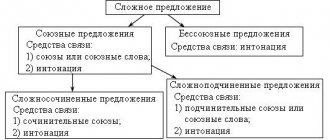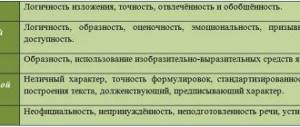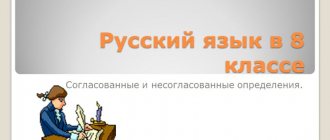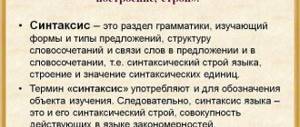Russian language lesson “Text and its plan”, 4th grade. School of Russia
Russian language lesson notes, 4th grade.
Topic: “Text and its plan.” Author: Bodenova Valeria Sergeevna, 3rd year student in specialty 02/44/02 Teaching in primary classes of advanced training. Description: This material will help primary school teachers. It is intended for children in 4th grade. Teachers can conduct a Russian language lesson on this topic. Objectives: to clarify ideas about the features of the text as a unit of speech; develop the ability to write a text outline. Formed UUD: cognitive - independent identification and formulation of a cognitive goal; conscious and voluntary construction of a speech utterance in oral and written form; building a logical chain of reasoning; proof; communicative - mastery of monologue and dialogic forms of speech in accordance with the grammatical and syntactic norms of the native language; regulatory - setting an educational task; comparison of the method of action and its result with a given standard; assessing the quality of the level of assessment of the material; personal - moral and ethical assessment of the acquired content, ensuring personal moral choice based on social and personal values. Equipment: Lesson developments in the Russian language for teaching materials of V.P.
Kanakina, V.G. Goretsky (“Russian School”), 4th grade / Authors - T.N. Sitnikova, I.F. Yatsenko. Progress lesson
1. Organizational moment. - Hello. - Be diligent in class. Be calm and attentive. Write everything without falling behind, Listen without interrupting. Speak clearly, clearly, so that everything is clear. If a friend begins to answer, do not rush to interrupt. 2. Updating knowledge. - Let's check your homework. (Children tell messages about polite words.) - Do you think it is necessary to be polite and why? - Read it. E. Shim-Birch.
We birch trees are good mistresses. We decorate the earth. Wherever you go, you will meet us everywhere. And in the dense forest there are birch trees. And in a swamp, among hummocks and mosses. Silky foliage rustles and whispers, birds build nests on the branches, light spills over the ground from the white trunks. — Can these sentences be called text? (Yes.) - Prove that this is a text. -What does the text say? - Find the spelling in the word birch and highlight it. — What tasks will we set for today’s lesson?
3. Studying new material.
Work according to the textbook.
Exercise 5 page 8. - Read these sentences.
— Can these sentences be text and why? (This is a text because the sentences are related to each other in meaning.) - What connection do sentences 2 and 3 have between each other? (The pronoun she indicates that we are talking about a birch.) - What epithet did the author use when describing a birch. (Green beauty.) - What does the text say? — How would you title the text? — Complete the tasks for the exercise. (Self-test and self-assessment.) Exercise 6 page 8.
- Read the poem.
— What feelings did you experience when you read the poem? - Read the poem expressively and try to convey the author’s feelings in your voice. -What does the poem say? (About the homeland.) - What is the main idea of the poem? (Children's answers.) - Write down this poem, following the rules when writing poetry. 4. Physical exercise. Our fingers worked and wrote well. They tried so hard, but now they are tired. We will rest a little and clench our fists with strength. We unclench our fingers and squeeze them again. One, two, three, four, five - You can wave them. We lower our hands into a clean stream, And we remove fatigue from our fingers with water (Children imitate washing their hands; the following words are pronounced as they exhale.) Thank you, water, for new strength. Now we will write all the letters beautifully. 5. Consolidation of what has been learned . Exercise 7 page 9.
- Read the text.
— What is the difference between the topic and the main idea of the text? The title of the text tells us what? — How can a text be divided into parts? — What parts of the text do you know? How are they different from each other? — What does the outline of the text consist of and what should it include? — Try to make an outline of this text. (Children work in pairs, and then one of the students voices his plan, and at the end the teacher and the students analyze and write a general plan on the board.) - Try to retell the text according to this plan. — Did the plan help you and how? Do you think it is necessary to draw up a text plan? 6. Reflection. — What does the text consist of? — How does the text differ from ordinary sentences? — What was the most interesting thing in the lesson? - Write down your homework, read page 9. - Thank you for your work.
We recommend watching:
Spelling dictation in 4th grade Synopsis of a Russian language lesson in 4th grade Synopsis of a Russian language lesson in 4th grade “Spelling of unstressed case endings of names exist Synopsis of a Russian language lesson in 4th grade
Similar articles:
Russian language lesson notes, grade 4. Homogeneous minor members of the sentence
Test work in the Russian language on the topic “Pronoun” in 4th grade
Test work in the Russian language on the topic “Homogeneous members of a sentence” in grade 4
Summary of a literary reading lesson in 4th grade on the topic: Satire and humor. Nikolay Nosov “Fedina’s task”
Final test work on the topic “Syntax”, 4th grade
so UNT / Lesson plans for the Russian language / Lesson plans for the Russian language grade 10
Lesson 28. WHAT IS TEXT?
24.07.2013 18841 0
Target:
introduce the features of a text and its functional and semantic types; activate the ability to determine the topic, the main idea of the text, analyze the structure and linguistic features of the text; create conditions for developing research skills.
Lesson type: combined.
Methods: heuristic conversation, research, independent work, creation of emotional and moral situations, written self-control, development and improvement of learned skills
During the classes
1. The stage of organizing joint activities to master the lesson material.
A report on the results of a mini-research on the topic of the lesson, prepared by students.
Material for teachers.
The term "text" (lat. textum
- fabric, connection, connection, adhesion) is understood differently in different branches of the science of language and literature. For example:
1) “A text can be defined as a message in written form, characterized by semantic and structural completeness and a certain attitude of the author to what is being communicated” (L. M. Loseva).
2) “Text is understood as a logically and structurally organized set of statements characterized by unity of theme” (E. S. Skoblikova).
3) “A text is a work of the speech-creative process, complete, objectified in the form of a written document, literary processed in accordance with the type of this document” (I. R. Galperin).
4) “Text is a finished, complete work” (from the textbook “Russian Language”, grade 10. Authors R. N. Buneev, E. V. Buneeva, L. Yu. Komissarova, O. V. Chindilova).
5) “Text is any work of literature, expressed orally or in writing, as well as a completed fragment of a work. This is both a separate paragraph and a whole book. The text can even be one sentence. The text represents the unity of content and the verbal form of expression of this content” (R. I. Albetkova)
.
6) “A text is a sequence of sentences, paragraphs, chapters, etc., united by a semantic connection, the main (categorical) properties of which are coherence, integrity and unity” (from the book: L. S. Stepanova, I. B. Maslova, A. V. Terentyeva. Russian language. Thematic training tasks).
7) “Text is a work of written or oral speech intended for communication. As a communicative work, the text carries a certain message and information. Actually, the text is created so that the author can convey some information to the reader” (from the book, see paragraph 6.).
Analysis of different definitions allows us to identify the following main features of the text:
Information content
(the content of any completed text is information on a specific topic or issue. The entire text is permeated by an idea, the main idea).
Dividing the text into certain parts
(chapters, microtexts), units (sentence, syntactic complex whole, paragraph). Division into paragraphs clarifies the composition (structure) of the text. The absence of paragraphs would make the text difficult to understand, devoid of compositional guidelines.
Connectivity
(all parts and units of the text are interconnected in meaning and lexico-grammatically).
Communicative intention of the author of the text
– communication, message, impact, creation of artistic, poetic images + emotional and aesthetic impact.
2. The stage of primary verification of understanding of what has been learned.
Working with deformed text.
The text is pre-printed. Every student receives it. The goal is to, based on the available information, restore the sequence of sentences by placing missing punctuation marks.
KUTSYY
1. This gesture aroused greedy attention in the dog.
2. My acquaintance with Kutsym happened completely by accident.
3. The proposal was accepted with full sympathy.
4. And from that very moment Kutsy was accepted into the crew of the Mighty.
5. Kochnev went into a small shop and a minute later threw the dog pieces of black bread and pieces of tripe bought with his own pennies.
6. We turned to the boatswain with a request to seek permission from the senior officer.
7. It was in Kronstadt on one stormy and cold Sunday day, three days before the departure of the “Mighty” three-masted military ship on a circumnavigation of the world.
8. Then Kochnev began to rummage in his pockets.
9. Her unhappy appearance aroused pity among the sailors.
10. Permission has been received.
11. The dog looked suspiciously with its intelligent eyes at the sailor, but a few further gentle words spoken in a benevolent tone reassured it about the bad intentions and it howled pitifully.
12. Writing intricate monograms with his feet, sailor Kochnev was returning to the corvette stationed in the military harbor and noticed a dog in the alley clinging to a drainpipe and shuddering from the cold.
13. Other than Kutsym, someone suggested not to call him anything.
14. Soon, having eaten her fill, she fell asleep not far from the galley and, not believing her happiness, often woke up anxiously in her sleep.
15. The sailor came closer and stroked her; she licked his hand, touched by the caress, and howled even stronger.
16. They began to pet her and took her downstairs to feed her.
17. The question arose about what nickname to give the dog.
18. “You are whose brother you will be,” he said, stopping near the dog.
19. The dog greedily rushed to the food and in a few seconds ate everything and again looked questioningly at the sailor.
20. The pitiful appearance of this homeless dog touched the sailor.
21. He whistled affectionately.
22. Everyone looked at a very unprepossessing dog, which, in response to affectionate glances, wagged its stump of tail and gratefully licked the hands of the sailors stroking it.
23. The next morning, the dog, awakened by the cleaning of the upper deck, looked around in fear, but Kochnev significantly calmed it down by placing in front of it a cup of liquid gruel from which the sailors had breakfast.
24. After some time, when the deck was washed, Kochnev took her upstairs and invited the sailors to leave her on the corvette.
25. The dog followed him and, not without some embarrassment, entered the corvette along the gangway and, following the sailor, found itself on the forecastle among a crowd of people, frightened and as if embarrassed by its unattractive appearance.
26. I liked the nickname.
Restored text.
KUTSYY
My acquaintance with Kutsym happened completely by accident. It was in Kronstadt on one stormy and cold Sunday day, three days before the departure of the Mighty, a three-masted warship, on a voyage around the world.
Drawing intricate monograms with his feet, sailor Kochnev was returning to the corvette stationed in the military harbor, and noticed a dog in the alley, pressed against a drainpipe and shuddering from the cold. The pitiful appearance of this homeless dog touched the sailor.
-Whose will you be, brother? - he said, stopping near the dog.
The dog looked suspiciously with its intelligent eyes at the sailor, but a few further kind words, spoken in a friendly tone, reassured it about the bad intentions, and it howled pitifully. The sailor came closer and stroked her; She licked his hand, touched by the caress, and howled even stronger.
Then Kochnev began to rummage in his pockets. This gesture aroused greedy attention in the dog.
Kochnev went into a small shop and a minute later threw the dog pieces of black bread and pieces of tripe, bought with his own pennies.
The dog greedily rushed to the food and in a few seconds ate everything and again looked questioningly at the sailor. He whistled affectionately. The dog followed him and, not without some embarrassment, entered the corvette along the gangway and, following the sailor, found itself on the forecastle among a crowd of people, frightened and as if embarrassed by its unattractive appearance.
Her unhappy appearance aroused pity among the sailors. They began to pet her and took her downstairs to feed her. Soon, having eaten her fill, she fell asleep not far from the galley and, not believing her luck, often woke up anxiously in her sleep.
The next morning, awakened by the cleaning of the upper deck, the dog looked around in fear, but Kochnev calmed it down significantly by placing in front of it a cup of liquid gruel, which the sailors used for breakfast.
Some time later, when the deck was washed, Kochnev took her upstairs and invited the sailors to leave her on the corvette.
The proposal was accepted with full sympathy. We turned to the boatswain with a request to seek permission from the senior officer. Permission was received. The question arose of what name to give the dog. Everyone looked at the very unsightly dog, which, in response to affectionate glances, wagged its stump of tail and gratefully licked the hands of the sailors who stroked it.
– There’s no way to call him other than Kutsim! - someone suggested. I liked the nickname. And from that very moment Kutsy was accepted into the crew of the Mighty. (According to K. Stanyukovich.)
3. The stage of consolidating and applying what has been learned.
The work of restoring the text has a high practical orientation and is carried out by students with great interest and desire. The guys see the results of their work: the text is born before their eyes.
Conversation based on the restored text.
– How did you restore the text?
– What helped you in your work?
– What knowledge of speech science and grammar did you use for your work?





